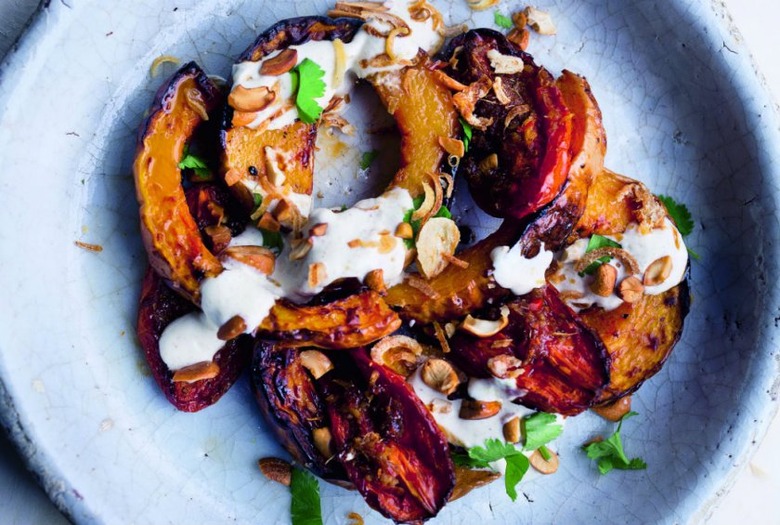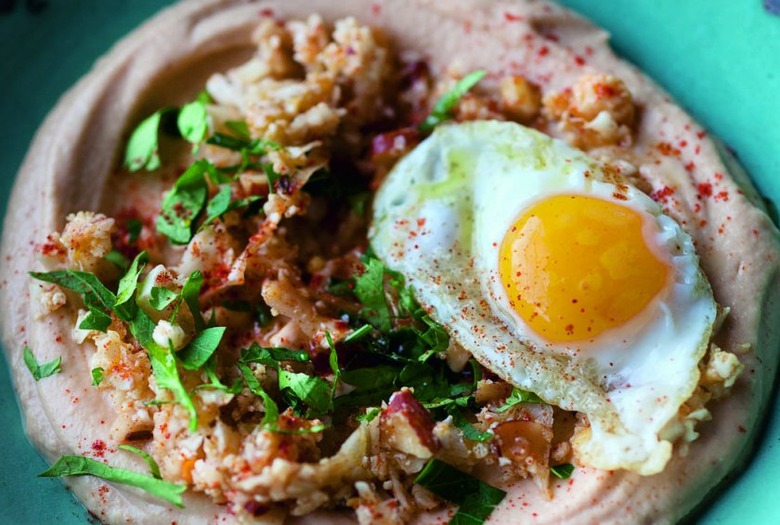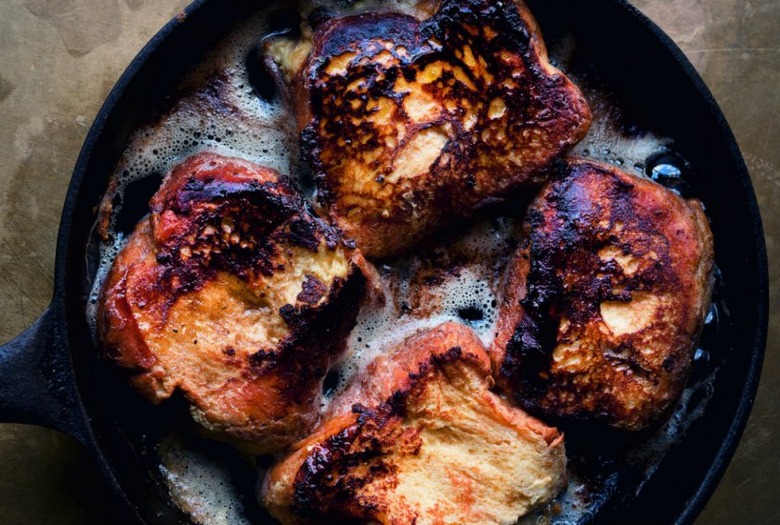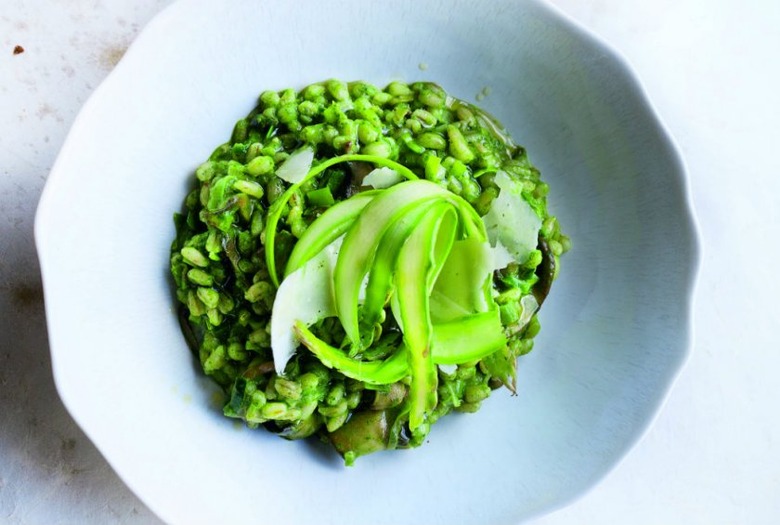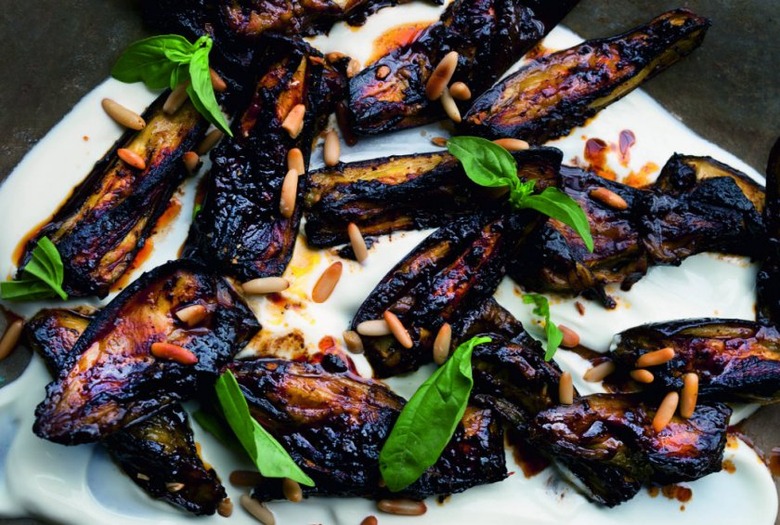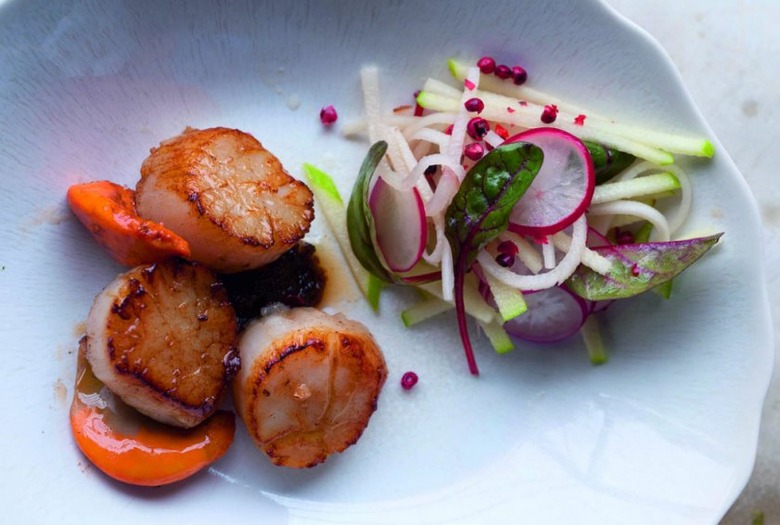The 'NOPI' Cookbook Brings Elegant Dishes From London's Acclaimed Kitchen Into Your Home
We may receive a commission on purchases made from links.
The scene is a bustling London restaurant: sleek, white bricked walls with the muted shimmer of golden brass accents; the food is exquisite Mediterranean with just a subtle hint of Asian flavor. All of the magic of Yotam Ottolenghi's NOPI restaurant has now been packaged into a clean, white hardback book with gold, glimmering binding. Ottolenghi and NOPI's head chef Ramael Scully have teamed up to write about the food they've been cooking for ages, and lucky for everyone at home, the new NOPI: The Cookbook makes restaurant-quality recipes accessible for the home cook.
Click here for the 10 Cookbooks Everyone Should Have slideshow.
The two have worked together in the professional kitchens for years, balancing Ottolenghi's knack for creating vibrant Middle Eastern-inspired platters, like the food in his cookbooks Plenty, Plenty More, Ottolenghi, and Jerusalem with Scully's tailored aesthetic and Malaysian flavor playbook. How else could you explain the appearance of a seared scallops dish garnished with pickled daikon or fresh ginger, crispy shallots, and Greek yogurt all mingling on the same plate of roasted butternut squash in this book?
Ottolenghi and Scully have succeeded in producing beautiful, decadent dishes that are as eye-catching as they are flavor knockouts.
In the introduction, they promise that while the flavor profiles and images in this book have all the trappings of chef-y finessed food, you can make these recipes at home without a culinary degree hanging on the wall. In fact, while they suggest a mandoline, spice grinder, blender, and ice cream machine will simplify things, they aren't a prerequisite when diving into the recipes in this book — basic kitchen tools will do just fine.
We had to opportunity to chat with Ottolenghi and find out what it was like working on this cookbook with Scully, and how their own unique signatures appear in each recipe:
The Daily Meal: What is your basic cooking philosophy and the Ottolenghi way of cooking?
Yotam Ottolenghi: I like to cook food that is familiar to me and, at the same time, full of bursts of surprising flavor. The dishes that I make take influence from all over — from the Middle East to the Far East — but this way of cooking — twists of surprise and delight in otherwise-comforting food — is a theme which holds many of my dishes together.
How did that influence the recipes in this book?
The primary influence for the recipes in the book came from the dishes we serve at the NOPI restaurant. That was our starting point and we then worked very hard to adapt them for the home cook.
I am used to creating and writing recipes with the home cook first and foremost in my mind. Scully, on the other hand, is used to creating and cooking recipes with the restaurant guest first and foremost in mind. There are lots of differences to these approaches — the recipes will often be much more composed in a restaurant and made of up more elements than the home cook would be used to preparing for one dish — but the process of writing the book was all about bridging this gap without compromising the end result.
We've really achieved this, I think, and I'm really proud of the fact that we have recipes which are not only completely doable and approachable for the home cook but, at the same time, which don't stray too far from the original version served at the restaurant.
You worked with Ramael Scully on this book, what was the process of melding your two styles of cooking?
Scully and I have been cooking and working together for many years now so we very much speak the same language in the kitchen. Scully's inclination is always to add an extra element to a dish and my inclination (contrary to popular belief!) is often to simplify a dish — suggesting a squeeze of lemon, for example, instead of a sorrel sauce Scully is suggesting; removing the fried shallots from a dish which already have a crunch from the toasted nuts.
Scully and I have always brought what we call our "signature" pantry goods to the stove top and have had a lot of fun — not just in this book but over the years — pairing these together in often great ways. Scully's soy and my tahini sauce, as just one small example, pair wonderfully in a salad dressing to be drizzled over chargrilled broccoli.
The dishes in this book are seemingly more complex than the food we saw in Plenty and Jerusalem. How did the two of you work to make this food approachable for the home cook?
They really aren't that much more complex. The big secret of the book is that, although a lot of the dishes seem more complicated and certainly have a built-in "wow" factor, they are actually very straightforward and relaxing to make. This is largely to do with how many of the dishes are made up of various elements, which can be prepared well ahead of time and then just put together when you are ready to serve. This makes them perfect dishes for dinner parties, for example, when you want to do all the work in the pre-guest calm, and then just relax in the knowledge that you just have a few steps left to take.
In terms of process, the recipes Scully provided me with were the ones he would cook straight from in the restaurant. The recipe would then go through several (often multiple) tests and re-tests to see which elements could be removed or simplified or replaced with something else. We didn't want to assume ownership of any fancy kit for our readers, so if the restaurant version called for something to be whipped up in a thermostat, vacuum packed, and steamed for 12 hours, as is the case for the caramelized yogurt we serve with the venison fillet, we would come up with a way of producing a similar result just using things that everyone would have at home, sieves and clean j-clothes (household cleaning cloths) and all sorts.
In some cases, the results were so great that we wondered why we go to all the complicated effort in the restaurant in the first place! Where a recipe has been simplified for the home cook, we're always really sure to give both options so that readers have a choice as to whether they want to take the short cuts or pull out all the stops that are pulled in the restaurant.
How do you hope readers will use this book?
We have included a section at the end of the book for standalone dishes for people who want to make a meal out of just one dish from the book. There are lots of dishes like this: the Lamb meatballs with Swiss chard, for example, the buttermilk cod with urid dhal, the pearl barley risotto, the five-spiced tofu with eggplant and on and on. We have also then given suggestions of dishes which all pair really well together for those who want to go down a more traditional NOPI route – where our guests tend to order three or four dishes each and then share them with the table. Again, so long as readers get a little bit organized with their shopping and their chopping, the preparation of a meal like this does not need to be complicated as so much of it can all be prepared in advance and then just be ready and waiting until it's time to serve.
As with all recipe books, though, the ultimate hope is that people will get to know and cook a handful of dishes so many times that they really take ownership of them, making them their own: That's the way to really build confidence and have fun in the kitchen, I think.
What is the ultimate take-away from the book?
When choosing what to cook, choose dishes that you want to eat and which make you happy. If you cook food that you love to eat and that you think taste delicious, chances are that everyone else will be happy too. It needs to be fun and very delicious.
Want to try a recipe?
Butternut Squash with Ginger Tomatoes and Lime Yogurt
Roasted wedges of squash and roasted slices of eggplant: These are two bad boys that have been around the Ottolenghi delis and NOPI restaurant for a very long time. Any new player has to have very good credentials to gain the respect of the old-timers and get a shot on the menu. The combination here of sweet roasted squash with lime-fresh yogurt and gingery oven-dried tomatoes was deemed to cut the mustard.
Ready-made crispy fried shallots can be found in Asian food stores. They're a nice addition but, with the crunch already provided by the cashews, the dish can stand well without them, if you prefer. — Yotam Ottolenghi and Ramael Scully
For the Butternut Squash with Ginger Tomatoes and Lime Yogurt recipe, click here.
Celery Root Purée with Spiced Cauliflower and Quail Eggs
Ras al hanout is a North African blend of sweet and hot spices, finely ground. There's no definitive list of the spices that are combined — hanout means "shop" in Arabic, and every shop has its own "top-of-the-shop" variety — but it usually includes ginger, cardamom, allspice, nutmeg, cloves, black pepper, and cinnamon. Ready-made varieties are widely available and generally fine, but feel free to add to them for your own top-of-the-shop creation. We find that we often need to add a bit more cinnamon when using ready-made varieties.
The celery root purée works well as an alternative to hummus, if you want to make just this to snack on before a meal. With the additional elements, though, it's a substantial starter or even a little meal in itself, served with some warm crusty bread or white pita.
We like to fry the eggs here — the crispy edges of a fried egg work particularly well with the purée — but soft-boiled also works, if you prefer.
As with many of the dishes in this book, the main elements here can be made in advance, ready to be put together just before serving and, in this case, before the eggs are cooked. If you make the purée the day before, just cover it with plastic wrap — actually touching the surface of the purée — to prevent its forming a skin. It's better at room temperature rather than fridge cold, so bring it out of the fridge at least half an hour before serving. — Yotam Ottolenghi and Ramael Scully
For the Celery Root Purée with Spiced Cauliflower and Quail Eggs recipe, click here.
French Toast with Orange Yogurt
Having sold the Super French Toast that appeared in Yotam's Plenty More as pretty much the definitive word on the matter, we momentarily questioned the inclusion of another French toast recipe here. It's such a brunch favorite of our NOPI regulars, though, that we weren't allowed to leave it out. — Yotam Ottolenghi and Ramael Scully
Pearl Barley Risotto with Watercress, Asparagus, and Pecorinorisotto
We know that the use of the word here should be in big quotation marks. People get very protective about the rules of their culinary heritage. Yotam's opinion about what is and what isn't allowed to go into the making of hummus, for example, is as unwavering as an Italian chef's rules for the ingredients list in a risotto. Disclaimers aside, making risotto with pearl barley adds bite and texture that work very well with the smooth, green watercress purée.
Start with thick-stemmed asparagus for this, if you can: It'll make it far easier to shave each spear with a vegetable peeler and get the ribbons you're after. Don't be put off from making this if asparagus is not in season, thin ribbons of zucchini — shaved raw with a vegetable peeler — work well as an alternative. One medium zucchini will be enough to produce about 6 ½ ounces/180 g of shaved ribbons. — Yotam Ottolenghi and Ramael Scully
For the Pearl Barley Risotto with Watercress, Asparagus, and Pecorino recipe, click here.
Roasted Eggplant with Black Garlic, Pine nuts, and Basil
We'll be thinking we've done pretty much everything that can be done with a tray of roasted eggplant, and then a new ingredient comes along to shake things up. We discovered black garlic around the same time that NOPI opened, and quickly became hooked. It has an addictive mellowness and depth of fermented flavor: part balsamic vinegar gummy candy, part licorice. Black garlic starts off as white garlic. Nothing is added to the cloves to make them change so fundamentally from one thing to another; they simply undergo a three-week heat process that transforms their natural sugars and amino acids. It's sold either as a whole bulb whose cloves you then need to peel, or in a small jar of slightly smaller cloves already separated and peeled.
This recipe benefits from being made a few hours before you want to eat it, for the flavors to really absorb and develop. The roasted eggplant wedges don't fully keep their shape once they're tossed in the garlic sauce, so don't worry if the result is slightly mushier than you'd expect: It'll be all the better to spoon on top of some toasted sourdough or pita bread.
With thanks to Gena Deligianni for this dish. — Yotam Ottolenghi and Ramael Scully
For the Roasted Eggplant with Black Garlic, Pine nuts, and Basil recipe, click here.
Seared Scallops with Pickled Daikon and Chile Jam
This is a complex yet elegant dish. To simplify it, you can leave out the chile jam and mix together a little sweet chile sauce, sunflower oil, Thai fish sauce, lime juice, and cilantro, using this to dress the scallops and leaves. Still, we would make the jam: It's completely addictive. Scully's mother and nine aunties (yes, all on his mother's side!) all have their own versions, each placing a different emphasis on the sour, spicy, sweet, and salty levels. Scully's order of preference, having played around with all the family recipes and consulted the authority on Thai cooking that is David Thomson, is sweet then sour then salty then spicy.
The recipe makes enough to fill a medium jar (14 ounces/400 ml), but you can double the recipe if you like to keep a larger jar in the fridge. It will last for a month or more and is really versatile: delicious with cold meat as it is spread in a cheese sandwich or spooned alongside some plain rice. Two disclaimers: First, don't be put off by the smell of the dried shrimp in the pan. It's not the ingredient's strongest selling point, we know, but the resulting taste more than makes up for it. Second, sorry about all the garlic peeling and, no, 24 cloves is not a typo! — Yotam Ottolenghi and Ramael Scully
For the Seared Scallops with Pickled Daikon and Chile Jam recipe, click here.
Angela Carlos is the Cook Editor at The Daily Meal. Find her on Twitter and tweet @angelaccarlos.
